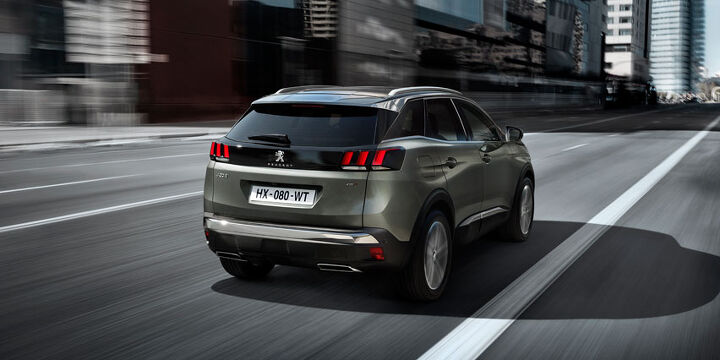You Know The Future For Mini MPVs Is Bleak When Even The Europeans Don't Want Small Vans
America’s mini-MPV market is dead. It was hardly ever alive.
Canada’s mini-MPV market is dying. The Chevrolet Orlando couldn’t make a go of it. Kia Rondo and Mazda 5 sales are 80-percent lower than they were a decade ago.
And if ever you thought North America’s mini-MPV market could be regenerated based off the strength of Europe’s compact minivan segment, you thought wrong. Even the Europeans — long lovers of small, family-friendly vehicles with affordable price tags, economical engines, and notable space efficiency — are turning away from mini-MPVs. In droves.
Why buy a minivan when you could have a rugged off-roader instead?
Or at least something resembling a rugged off-roader.
Granted, European compact minivan buyers seem to know the difference between a crossover and a mini-MPV with hints of crossover. Renault’s recent redesign of the Scenic brought SUV cues to the popular family hauler, yet those cues have done little to spur demand. European Scenic sales are up, but through the early part of 2017, the modest gains are what you’d expect to see from an all-new model.
According to JATO Dynamics, the launch of a new Volkswagen Touran spawned greater popularity in 2016 than in 2015, but sales in early 2017 declined and the Touran is now under serious threat from the new seven-seat Tiguan Allspace. “We still see a solid place for Touran in our sales,” Alison Jones, Volkswagen’s brand director in the UK, told Automotive News Europe.
But is it more likely the Touran will eventually go the way of rivals? You’ll no longer see Fiat, Honda, Mazda, Seat, and Skoda competing in the Touran’s space.
Meanwhile, when Peugeot replaced the 3008 mini-MPV with an identically named 3008 crossover, sales doubled. Indeed, the new 3008 is currently outselling even the Touran, Europe’s most popular people carrier, according to JATO Dynamics.
Mini-minivans continue to be numerous on European roads. Indeed, the MPV category continues to be a far more consequential segment in Europe than on this side of the Atlantic. In France, for instance, MPVs accounted for 7 percent of new vehicle sales in 2017’s first two months. But French MPV sales are down 16 percent compared with 2016, a year in which MPVs accounted for nearly 9 percent of the market. Likewise, Automotive News Europe reports, seven of the ten biggest minivan markets in Europe have seen sales fall precipitously in early 2017.
Again, the level of popularity, while clearly unsustainable, pales in comparison to the achievements of mini-minivan upstarts in North America. At its peak in 2008, the Kia Rondo/Mazda 5 segment yielded only 50,666 sales.
That was only 8 percent of the overall minivan market, and only 0.4 percent of the new vehicle market overall.
Timothy Cain is the founder of GoodCarBadCar.net, which obsesses over the free and frequent publication of U.S. and Canadian auto sales figures. Follow on Twitter @timcaincars.
More by Timothy Cain
Latest Car Reviews
Read moreLatest Product Reviews
Read moreRecent Comments
- NotMyCircusNotMyMonkeys so many people here fellating musks fat sack, or hodling the baggies for TSLA. which are you?
- Kwik_Shift_Pro4X Canadians are able to win?
- Doc423 More over-priced, unreliable garbage from Mini Cooper/BMW.
- Tsarcasm Chevron Techron and Lubri-Moly Jectron are the only ones that have a lot of Polyether Amine (PEA) in them.
- Tassos OK Corey. I went and saw the photos again. Besides the fins, one thing I did not like on one of the models (I bet it was the 59) was the windshield, which looked bent (although I would bet its designer thought it was so cool at the time). Besides the too loud fins. The 58 was better.




































Comments
Join the conversation
Choice isn't all that good in Europe anymore either. As you say, Peugeot replaces an ageing MPV with a less spacious, more phony model, just as others do the same. I asked Honda Norway if there was a chance we could get the Jade. There wasn't, since Honda Europe isn't taking in a small MPV now. Honda has even stopped importing cars to Norway on its own - it's now done by a private import company - so whatever strategy they employ doesn't seem to work so awfully well anyway.
I think our next vehicle is going to be the extended Transit Connect 7 seater. Minivans are gargantuan and expensive. I don't need 250+ HP - just drove our Prius C to Yosemite from SF and we passed plenty of cars on the two lane parts of the road. Got 50+ mpg too. The only problem with the TC is low fuel economy. Our household works at a smaller and more efficient scale than the average American household; our family car was a Passat wagon for the first few years we had 3 kids. 3 kid car seats would fit in the back seat. 40 cu ft of luggage space that was rectangular without interior sculpting intrusions. The TC in the 5 passenger configuration has 60 cu ft of cargo space. With 40 now, that's quite a bit more.